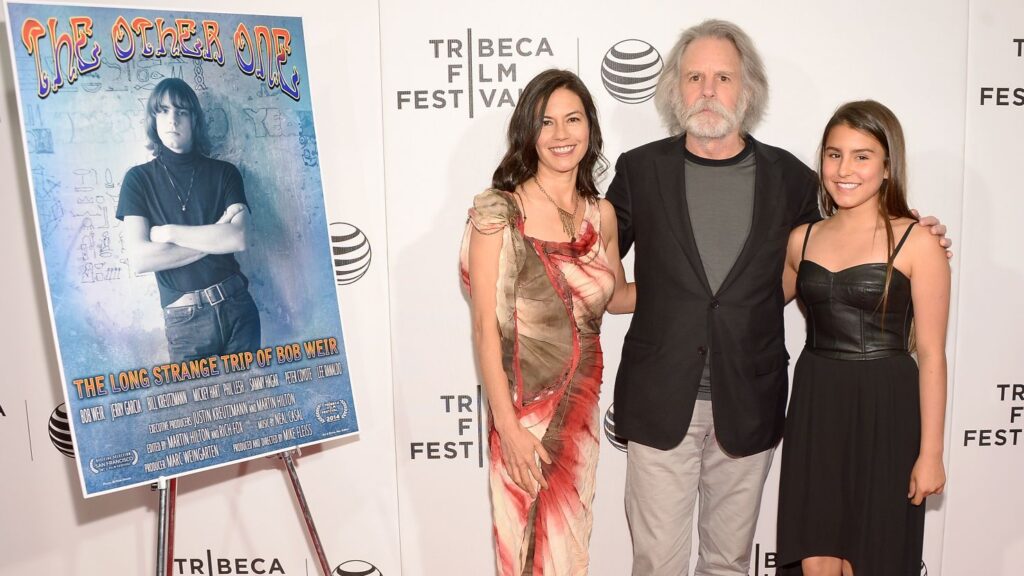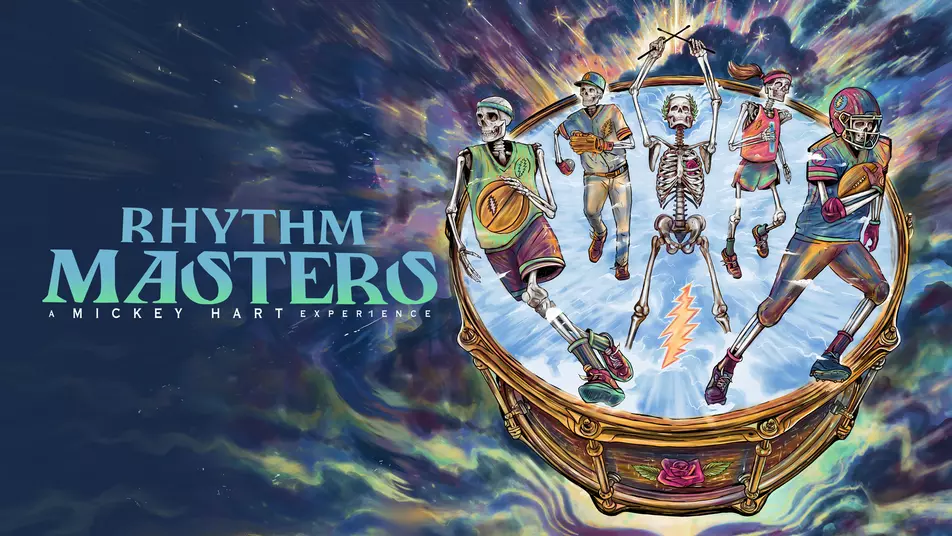Welcome, fellow sonic adventurers, to Dead Set Live! Tonight, we’re not just playing live music; we’re taking a deep dive into the extraordinary life of a man whose guitar strings have vibrated through decades of counterculture, improvisation, and an unparalleled musical journey. Get ready for a special edition of “The Ace Radio Show: A Look Back: The Grateful Dead and Bob Weir’s Long Strange Trip,” where every note, every anecdote, is steeped in the raw authenticity of a live performance and the candid reflections of a true legend.
Bob Weir. The name itself conjures images of psychedelic swirls, endless jams, and a musical legacy that defies categorization. While the media often portrays the Grateful Dead through a specific lens, a recent documentary, “The Other One: The Long Strange Trip of Bob Weir,” directed by Mike Fleiss, pulls back the curtain on the man behind the music, revealing a perspective that even the most devoted Deadheads might have “had it wrong” about. And here at Dead Set Live, we’re all about peeling back those layers, especially when it comes to the unvarnished truth of live experience.
Beyond the Spotlight: The Unseen Laughter and Unwritten Rules
For decades, fans revered the Grateful Dead for their onstage chemistry, their improvisational prowess, and the communal experience of their live shows. But as Weir himself reveals, the true magic often happened offstage. What he misses most from those touring years isn’t the roaring crowds or the endless musical exploration, but the “laughs, the yucks” shared amongst the band members. “That’s the only way we were able to stick together for all those years,” he muses. Imagine the chaotic, brilliant repartee that would send onlookers fanning themselves, bewildered by the sheer “nuts” energy of it all. This informal, joyous camaraderie wasn’t just a byproduct; it was the unseen engine fueling their on-stage telepathy, a living, breathing component of their unique sound. It’s a powerful reminder that the best live performances aren’t just about the notes played, but the human connection that binds them.
Weir’s unique guitar style, a rhythmic, almost percussive approach, was born from an unexpected source: jazz pianists. This influence, combined with the band’s willingness to “extend the rhythm of a song” for audiences under the influence of LSD, forged a truly extemporaneous approach to their craft. “The same song on a different day was a different song,” he affirms. This fluidity, this “will-o’-the-wisp” method of creation, is precisely what made every Grateful Dead live show a singular event. No set formula, just pure, unadulterated musical intuition. This wasn’t about rehearsed perfection; it was about the moment, a spontaneous combustion of creativity that only live performance can truly capture.
Revelations from the Trip: Five Unlikely Insights
While the dream of a full Grateful Dead reunion remains a fervent hope for many, Weir’s cryptic “We’ve got our best people on it” suggests that some things are best left to unfold naturally. However, Fleiss’s documentary, and by extension, our exploration tonight, offers a fresh batch of insights that deepen our understanding of Bobby and the band. Prepare for some revelations that might just surprise even the most seasoned Deadhead:
- The Merry Pranksters and the Acid Tests: Before the Grateful Dead became a phenomenon, a teenage Bob Weir ran away with none other than author and LSD advocate Ken Kesey and his infamous Merry Pranksters. Imagine the scene: a Beatles concert leading to an impromptu immersion into the genesis of counterculture, where the Dead played their first gigs at Kesey’s legendary “acid test” parties. Weir vividly recalls seeing guitars move like “snakes” and musical notes become visible – a testament to the powerful, often overwhelming, sensory experiences of those early days. He even admits to needing to “flee” when the intensity became too much. This foundational period, steeped in uncontrolled experimentation, directly shaped the band’s willingness to push sonic boundaries in their live performances.
- Beyond the Stage: Scuba Diving with Jerry: In a truly unexpected revelation, we learn that Bob Weir and Jerry Garcia shared a unique bond far from the concert halls: scuba diving. Picture it: the two legends, weightless underwater, with Garcia even tickling an eel on the chin. Weir recounts the “lot of fun underwater,” highlighting Garcia’s particular joy in the buoyancy that freed him from the physical constraints he experienced on land. These intimate, off-kilter moments paint a picture of a friendship that transcended the music, adding another layer to the complex tapestry of their lives.
- The Unspoken Burden: Jerry’s “Bag Man”: The Grateful Dead’s association with drugs and partying is well-documented, but the film offers a poignant glimpse into the band’s concern for Jerry Garcia’s escalating drug use. Weir reveals a time when he became Garcia’s “bag man,” holding and limiting his access to heroin, marijuana, and cocaine. This wasn’t about judgment, but a deep, empathetic effort to care for their troubled frontman. It underscores the profound personal toll that fame and a chaotic lifestyle can take, and the quiet, often unacknowledged sacrifices made within the band. Even amidst the most exhilarating live performances, there were always underlying struggles.
- A Rock and Roll Hall of Fame Hangover: Even rock gods have legendary hangovers. The night the Dead were inducted into the Rock and Roll Hall of Fame in 1994, Weir admits to “partying fairly heavily.” The morning after? He awoke “under a table with the legendary Chuck Berry.” “We saw the wrong end of sunrise,” he quipped. This anecdote, delivered with trademark dry wit, perfectly captures the larger-than-life, often hedonistic, reality of rock and roll at its peak. It’s a reminder that even the most profound musical experiences were often intertwined with exuberant, unrestrained celebration.
- The Unwanted Stardom of “Touch of Grey”: Despite their immense popularity, the Grateful Dead, and particularly Jerry Garcia, sought to “sidestep fame.” Their biggest hit, “Touch of Grey,” inadvertently thrust them into a level of mainstream stardom they never truly desired. Weir recounts unsettling incidents, like a fan purposefully trying to be hit by Garcia’s van to establish a “connection.” This newfound notoriety meant they could no longer move freely in public, often confined to hotel rooms on the road. It’s a bittersweet irony: the song that brought them unprecedented success also curtailed the freedom that had defined their early, communal existence. The live experience became more controlled, less spontaneous in its audience interaction, a direct consequence of their unexpected chart-topping success.
Bob Weir’s journey, as illuminated by Fleiss’s documentary and our “Ace Radio Show” retrospective, is a testament to a life lived on his own terms, driven by an insatiable musical curiosity and an unwavering commitment to the live experience. From the wild abandon of the acid tests to the quiet moments of friendship underwater, and the challenges of fame, his story is as complex and improvisational as the music he creates. So, turn up your speakers, because tonight on Dead Set Live, we’re not just celebrating a musician; we’re celebrating a true original whose long, strange trip continues to unfold, live and in living color.
Bob Weir’s Ever-Evolving Legacy – A Deep Dive into His Live Projects
Welcome back, music explorers, to Dead Set Live, the only place where every note you hear is plucked, strummed, or belted out from a genuine live performance! Tonight, we’re setting our sights on a true living legend, a foundational pillar of the Grateful Dead universe and a tireless innovator in his own right: Bob Weir. Prepare yourselves for an auditory journey through “The Ace Radio Show: Live Music from Bob Weir and His Solo Projects,” showcasing how Bobby consistently pushes the boundaries of live music.
From the improvisational brilliance of the Grateful Dead to his current captivating endeavors, Bob Weir has always embraced the raw, untamed energy of the stage. His solo projects aren’t just offshoots; they’re vital, breathing extensions of his musical spirit, constantly evolving and delivering unique sonic experiences that resonate deeply with fans across generations. And as we dig into the details of his recent activities, it’s clear the man shows no signs of slowing down.
Bobby Weir & Wolf Bros: Orchestral Expansions and Intimate Jams
At the forefront of Bobby’s current musical universe is Bobby Weir & Wolf Bros. This band, featuring the stellar talents of Don Was on bass and Jay Lane on drums, has become a dynamic platform for reinterpreting Grateful Dead classics, delving into Weir’s solo catalog, and exploring new sonic landscapes. What makes Wolf Bros truly special, especially in recent times, is their adventurous collaboration with symphony orchestras.
Imagine the sprawling tapestry of “Terrapin Station” or the cosmic expanse of “Dark Star” interwoven with the majestic sweep of a full orchestra. This isn’t just a novelty; it’s a profound artistic statement. Recent and upcoming symphony collaborations with esteemed ensembles like the Cincinnati Pops Orchestra, Chicago Philharmonic, and the Louisiana Philharmonic Orchestra are a testament to Weir’s unwavering commitment to pushing creative boundaries. These performances offer a fresh, expansive perspective on beloved material, showcasing the intricate layers and timeless beauty of the compositions in a way that only a live orchestral setting can provide. We’re talking about an entirely new dimension of immersion, where the familiar feels grander, more intricate, and utterly captivating.
Grateful Dead’s 60th: A Trio Vision and a Lingering Legacy
The air has been thick with speculation surrounding the Grateful Dead’s 60th anniversary. While the unfortunate passing of Phil Lesh in October 2024 certainly changed the landscape, Bobby Weir has openly expressed his thoughts on a potential reunion. His vision? A powerful trio, reuniting with drum titans Bill Kreutzmann and Mickey Hart.
It’s a bittersweet notion, acknowledging the irreplaceable void left by Lesh’s distinct bass contributions, yet simultaneously highlighting the enduring bond and improvisational spirit of the remaining core members. The Grateful Dead’s live experience was always about the collective, the spontaneous interaction, and the deep, almost telepathic connection between the musicians. A trio format, while certainly different, would undoubtedly lean into the rhythmic prowess of Kreutzmann and Hart, creating a percussive foundation for Weir’s iconic guitar and vocals. While plans might be in flux, the mere possibility of these three maestros sharing a stage again for such a momentous occasion is enough to send shivers down any Deadhead’s spine. It speaks to the ongoing, living legacy of the band, a legacy that continues to find new forms of expression.
Dead & Company: The Sphere Experience and Beyond
Of course, the vibrant force of Dead & Company continues to captivate audiences, with their residency at the Las Vegas Sphere being a major highlight. Weir himself has spoken about the Sphere offering “unique storytelling opportunities,” a concept that perfectly aligns with the immersive, psychedelic nature of a Dead & Company performance.
Think beyond just sound; envision the visual spectacle, the projection mapping, and the unparalleled sound system transforming the live experience into something truly multi-sensory. Dead & Company’s Sphere shows are not merely concerts; they are meticulously crafted journeys that leverage cutting-edge technology to enhance the improvisational magic the band is known for. Each night is a unique setlist, a fresh exploration of the Grateful Dead songbook, now amplified by the Sphere’s revolutionary environment. This residency further cements the idea that live music, in the hands of artists like Weir, is a constantly evolving art form.
The Story Continues: Books, Biopics, and the Endless Journey
Beyond the stage, Bob Weir’s creative endeavors extend to other fascinating realms. The mention of him working on a book offers an exciting glimpse into the potential for a deeper, more personal narrative from one of rock’s most enigmatic figures. Imagine the untold stories, the road tales, the philosophical insights from decades spent at the heart of a cultural phenomenon. A book from Weir promises to be an invaluable addition to the vast literature surrounding the Grateful Dead and the counterculture.
And the prospect of a Grateful Dead biopic with Weir’s involvement? That’s a true game-changer. The Grateful Dead’s story is ripe for the big screen, a swirling saga of music, community, improvisation, and a singular American experiment. With Weir’s input, such a project would offer an authentic, insider’s perspective, ensuring the narrative captures the true essence of the band’s unparalleled journey.
Bob Weir’s commitment to live music, his ceaseless innovation, and his willingness to explore new avenues ensure that his legacy, and the spirit of the Grateful Dead, remains vibrantly alive. Whether he’s leading the Wolf Bros with a symphony, considering a historic trio reunion, or pushing the boundaries of immersive performance at the Sphere, Bobby Weir reminds us that the best music is always in motion, always evolving, and always, truly, live. Tune in tonight to The Ace Radio Show and experience the living legacy for yourselves!



